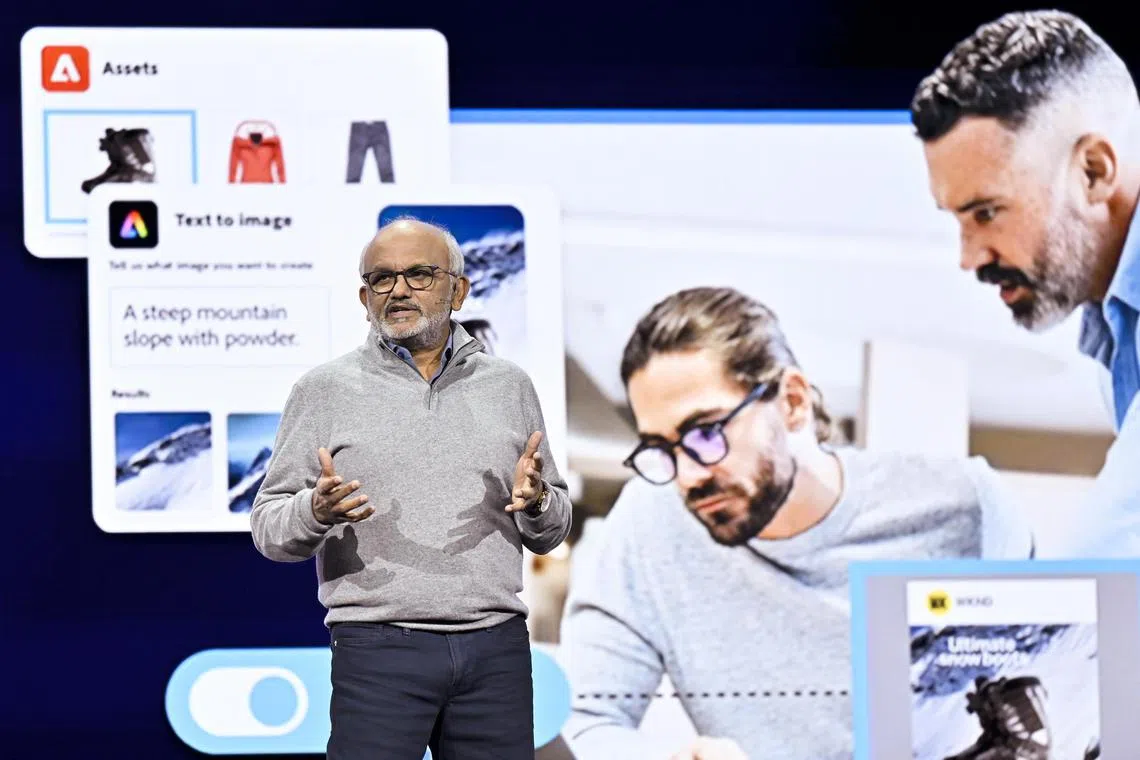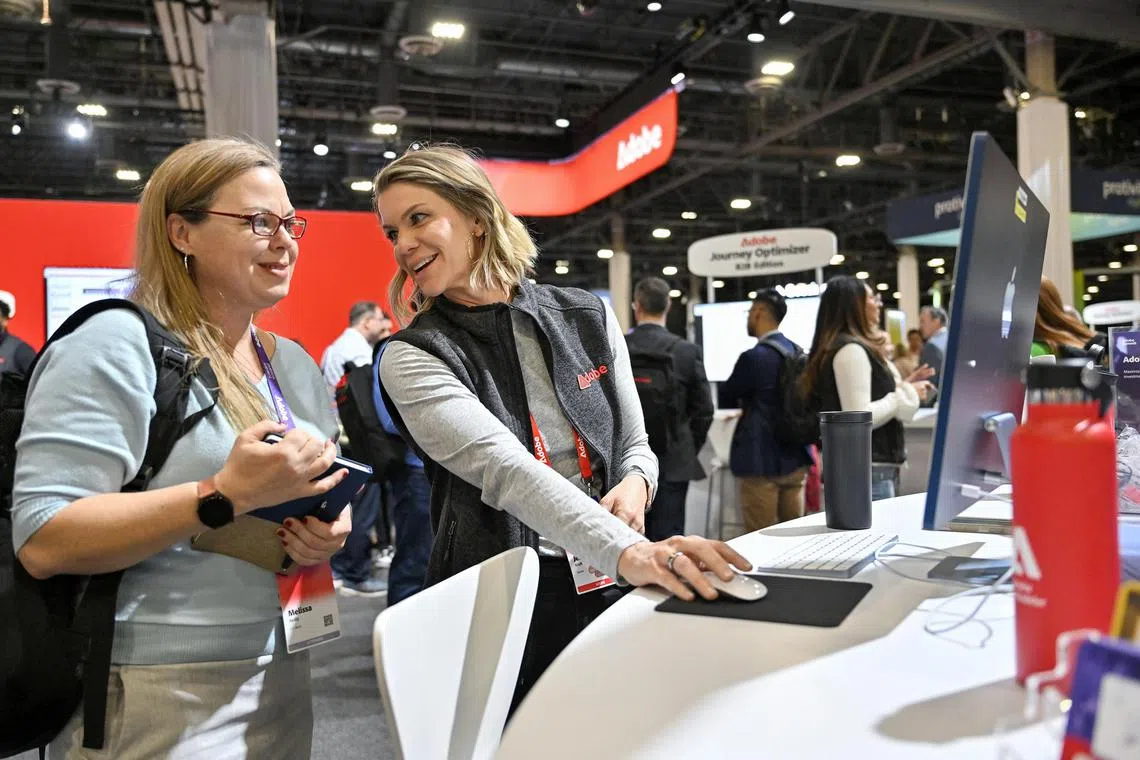‘Make me an ad and find the customers’: Adobe rolls out AI tools for marketers
Sign up now: Get ST's newsletters delivered to your inbox

Adobe’s chairman and chief executive Shantanu Narayen at the Adobe Summit in Las Vegas, on March 26.
PHOTO: ADOBE
Follow topic:
LAS VEGAS - From making briefs and ads to tracking customers’ reactions, a suite of new generative artificial intelligence (AI) tools for marketers was rolled out by Adobe on March 26 to help them mount ad campaigns.
When given text commands, the applications will not only respond with creative visuals or social media posts, but also dish out ideas on customer segments and ways to engage them.
These AI tools will even personalise e-mail pitches, in the hope of saving them from spam bins.
To ease marketers’ perennial bugbear of having to loop in various colleagues and agencies over different stages of a campaign, a solution called Adobe GenStudio will bring teams into a common virtual workspace.
The new product, first shown in October 2023, pulls together various Adobe apps across planning, content creation and creatives’ inventory, ad deployment and measurements, raising transparency and coordination.
The maker of Acrobat and Photoshop made its flurry of 14 product launches to 11,000 guests at its annual Adobe Summit in Las Vegas where, in the same hall a year ago, it launched its first generative image tool Firefly.
Reflecting users’ calls for interoperability, it also announced plans to let Microsoft 365 Copilot users tap its AI-powered workflows and insights.
Like Microsoft, after talking about generative AI and experimenting with it for most of 2023, the San Jose-based software maker now wants to demonstrate the technology’s practical use.
Mr Anil Chakravarthy, Adobe’s president for digital experience business, said the company is ready to take the “shiny new toy” into production to yield real business value.
The AI era means a rise in customer expectations for personalisation, he said. For firms, it means talking to every customer as individuals – thousands or millions of them at any one time.
These bespoke messages mean marketers must churn out an avalanche of content, find their customers quickly and know their wants almost immediately.
Such pressures extend even to sectors like healthcare.
Speaking at the conference, pharmaceutical firm Pfizer’s chief digital and technology officer Lidia Fonseca said: “You might be surprised by the amount of content that Pfizer generates. We develop materials to educate physicians, patients and their families at every stage of their health journey, from disease prevention, screening, treatment and post-treatment options.”
Use of automation and AI has halved medical and legal review and approval times, and made content creation 75 per cent faster, she said. “Speed is critical, because the sooner patients understand their options and start on therapy, the faster they can be on the path to wellness.”
Analysts said the most significant piece of news by Adobe was the offering of Firefly Custom Model. This new capability lets firms train Adobe’s existing Firefly model on in-house proprietary creative assets and brand style.

Adobe made its flurry of 14 product launches to 11,000 guests at its annual Adobe Summit in Las Vegas, on March 26.
PHOTO: ADOBE
Mr Ray Wang, chief executive of Constellation Research, said: “To have the security, that’s important to enterprise. What Adobe is doing is providing the tools between Adobe GenStudio, and the different types of models, to get you there.”
Later in 2024, Firefly will be expanded beyond pictures to offer designers the possibilities of video, audio and three-dimensional graphics. It will also be enhanced to scale up output.
Mr Wang said: “We haven’t seen pricing yet. So we do want to see where the pricing is for all the AI features. If you build (the model) yourself, you have to get really good at managing the amount of tokens you are using, understanding how the economics are going to work out. I think on Adobe, they have done the optimisation for you.”
Mr Simon Dale, Adobe’s vice-president for Asia, said Singapore’s Economic Development Board has urged the firm to help companies in the Republic implement AI in ways that make an impact.
“Not just play around with it. Not just to teach them skills to build AI, but actually have AI that is impactful,” he said.
For instance, with South-east Asia’s diversity, the custom model can reflect the local flavours. “That’s where the custom models and the training would make a big difference,” he added.
Nervous and light-footed investors are watching closely as tech firms begin to execute on promises of implementing in 2024 a technology that guzzles capital to build and compute.
Despite record US$21.3 billion (S$28.7 billion) revenue projected for the 2024 financial year, conservative guidance by Adobe’s management in March after its latest earnings quarter led to a 14 per cent drop over a day in its share price.
Just a month before, in February, its share price slid 7 per cent over fears of competition after the release of a text-to-video generation tool called Sora by OpenAI.
But Mr Jay Pattisall, principal analyst at research firm Forrester, said: “Sora looks like a really nice PR campaign right now. To take the sarcasm out of my response, I mean they have shown us demonstrations so far and have restricted the access to very few, which suggests to me that it is not ready for prime time.”
Adobe, a 41-year-old company, has demonstrated a practical bent in its AI pursuit, he said. “Adobe has been incredibly successful thus far. It very much painted a vision for the future with developing a commercially viable service for generative AI. I think they will continue to succeed.”
Adobe’s chairman and CEO Shantanu Narayen could have let slip where the firm has its eyes on in the long term. In his keynote address, he said: “Today, technology enables us to predict consumer preferences and offer tailored recommendations. Tomorrow, AI-driven comprehension in agents will enable us to offer solutions that anticipate customer needs.”


